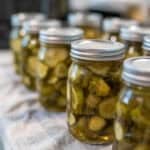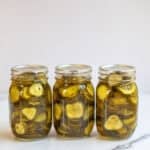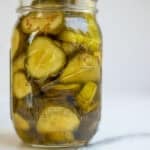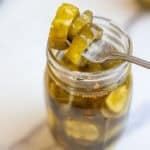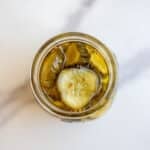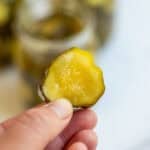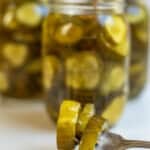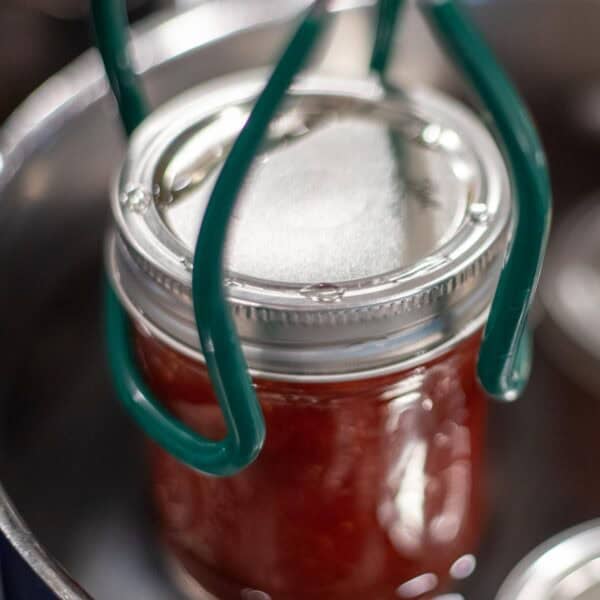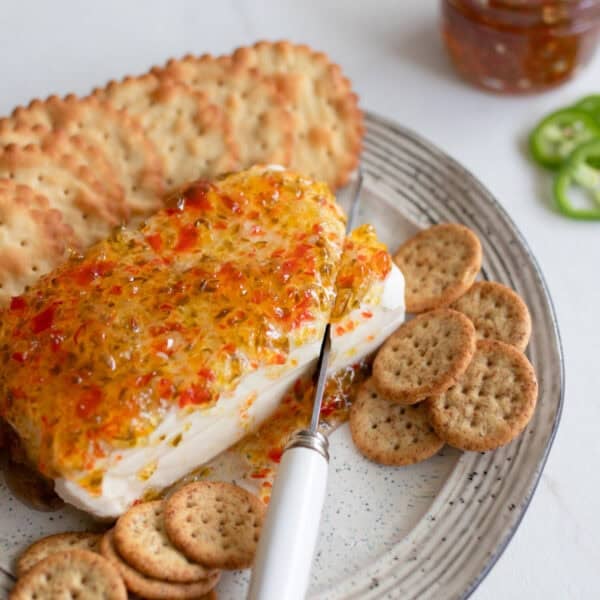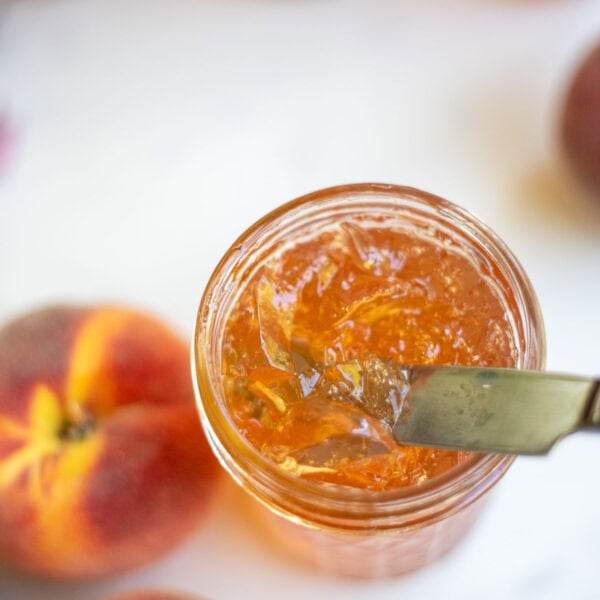This old-fashioned lime pickles recipe utilizes pickling lime to transform fresh cucumbers into crunchy, sweet pickles that are nostalgic, tangy, and delicious.
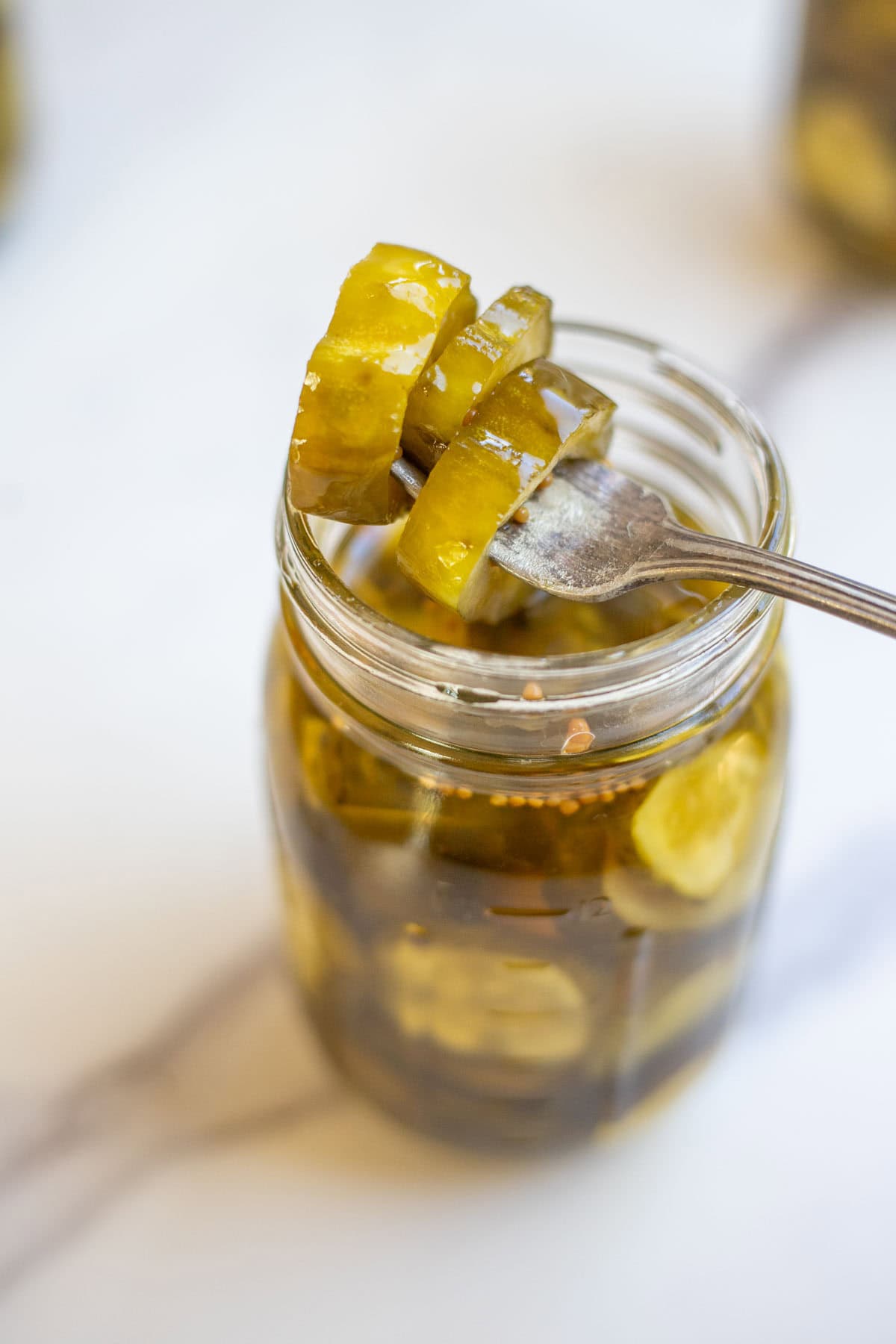
What’s the perfect side dish to a homemade sourdough grilled cheese sandwich? I would argue for sweet pickles. Particularly, the crunchy, sweet, sour, mildly spicy sweet pickles from childhood.
This lime pickle recipe fits that description precisely – crunchy, sweet, and sour. Lime pickles are nostalgic and old-fashioned. A recipe perfect for stocking the pantry, enjoying through the year, or sharing as a homemade gift. Between the time and the effort, these homemade pickles develop great flavor and hold an impressive crunch.
This crunch comes from pickling lime, which is a food-grade calcium hydroxide. It’s a white powder that, when dissolved in a solution and used to soak veggies, strengthens the pectin in the vegetables. (It’s also great for water glassing eggs!) This results in crisp veggies. Homemade lime pickles are crisp and sweet, the perfect side to a savory meal like ham and Swiss sliders or sourdough stromboli. You should also try them chopped up in homemade egg salad or deviled eggs for a delicious pop of flavor and texture.
Because calcium hydroxide sounds intimidating, you might wonder if it’s safe. In small quantities – like the small amounts absorbed by fresh veggies – it is harmless. The residual lime or lime settled on the vegetables without rinsing would be problematic, which is why recipes for lime pickles undergo a series of thorough rinses and soaks. These efforts ensure the veggies only retain the lime that has strengthened the pectin, leaving behind a crisp veggie and no extra residue. The rinses and vinegar-heavy brine also ensure safe canning, keeping the acidity levels where they need to be to eliminate bacteria and contamination, since pickling lime is alkaline and would reduce acidity if left on the pickles during canning.
If you’re new to canning, see my water bath canning beginner’s guide to get started.
Why You’ll Love This Recipe
Extra crunchy – Homemade pickles tend to start out crunchy and then go soft. Not with pickling lime. This recipe keeps the pickles crunchy even after all the processing time.
Sweet and nostalgic – These are the pickles I remember as a kid, yet fully appreciated as an adult. They are canned in a sweet syrup of vinegar and sugar, a delicious balance of sweet and sour.
Shelf-stable – Canned lime pickles will last up to a year, sometimes more, when properly processed and fully sealed.
Ingredients
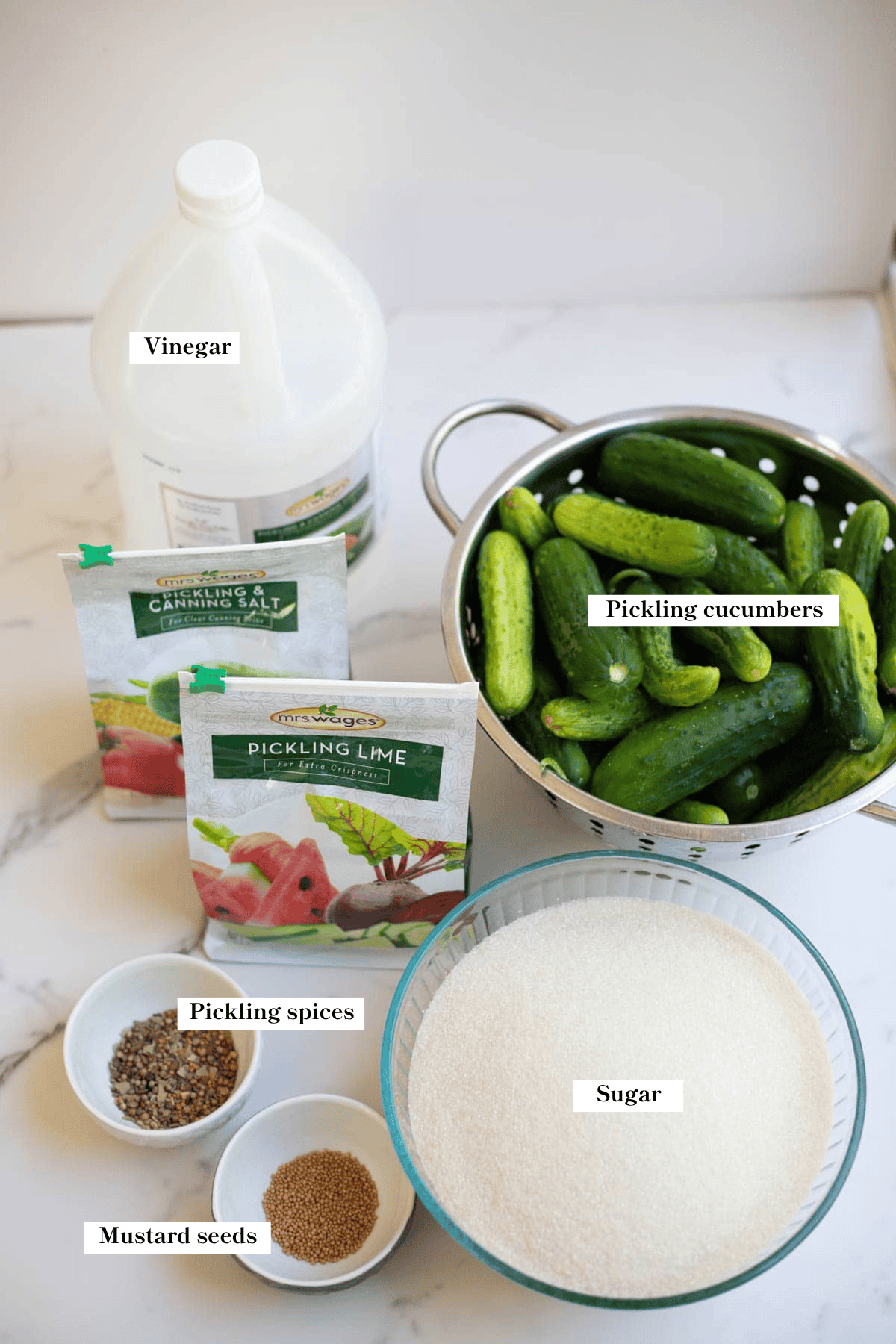
Pickling lime – Be sure the product is labeled food-grade, not agricultural or builder’s lime.
Cucumbers – Use pickling cucumbers for best results. Not all cucumbers make the best pickles.
A full ingredient list with exact amounts can be found in the recipe card below.
Tools You May Need
Wide-mouth canning jars, lids, and bands
Water bath canner and tools (See water bath canning beginners’ guide)
How to Make Lime Pickles
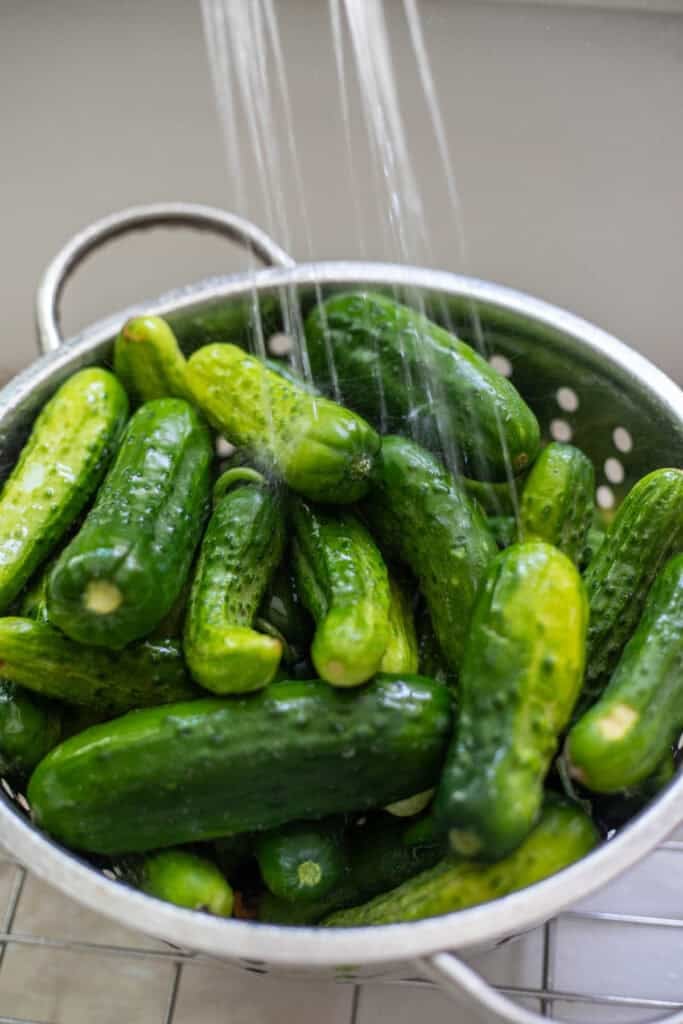
Step 1: Wash and prepare cucumbers. Scrub the outside to remove all cucumber spines, then cut off the blossom ends. Cucumber ends may contain an enzyme that softens them in the jars. Slice the cucumbers into thin medallions about 1/4 inch thick.
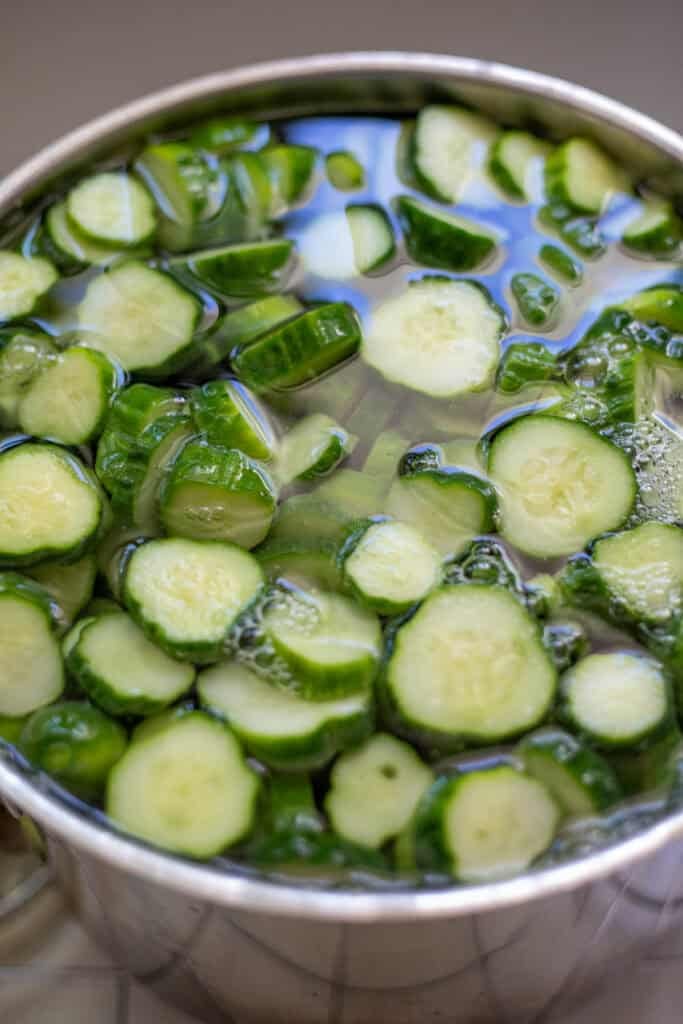
Step 2: Stir the water and pickling lime into a large non-reactive bowl (glass, plastic, ceramic, or stainless steel). Do not use an aluminum bowl, as lime will react with aluminum. Stir until the lime is dissolved, then add the sliced cucumbers to the lime soak solution. Add a bowl or plate as a weight over the cucumbers to keep them submerged. Soak for 12 hours, stirring occasionally and replacing the weight. You will notice some bubbling, which is expected as the air is being released from the cucumbers.
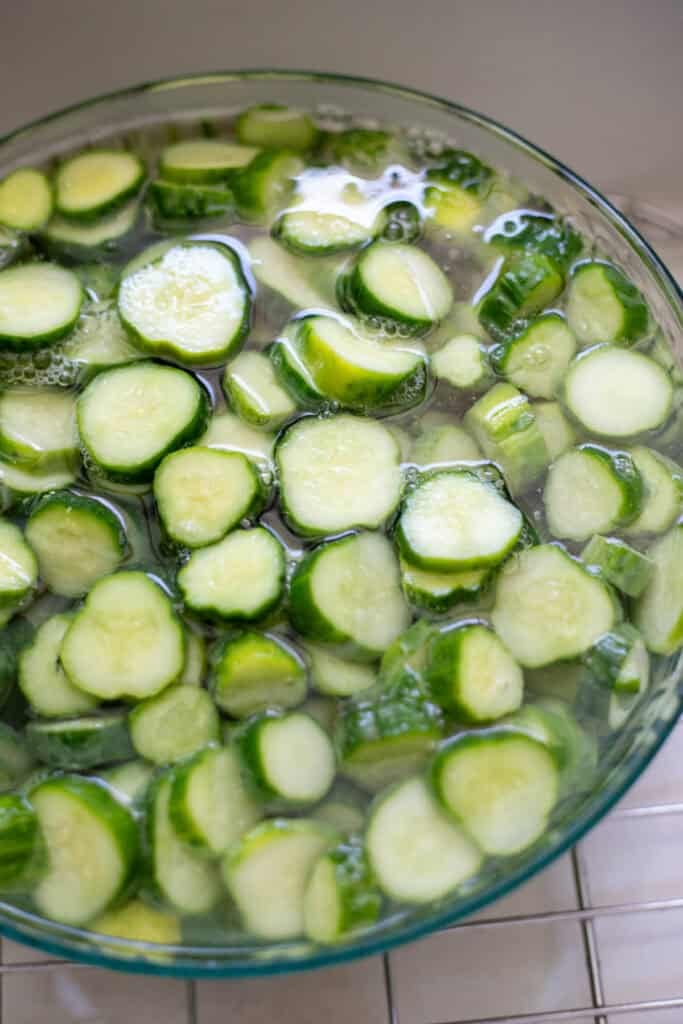
Step 3: After the first soak is complete, pour off the lime solution and rinse the cucumbers thoroughly in a colander to remove all lime residue. Repeat the rinsing process three times, straining and gently tossing or stirring the cucumbers during each rinse. Add the cucumbers to a large, clean bowl, cover with ice water and a tea towel or lid, and soak for another 3 – 4 hours.
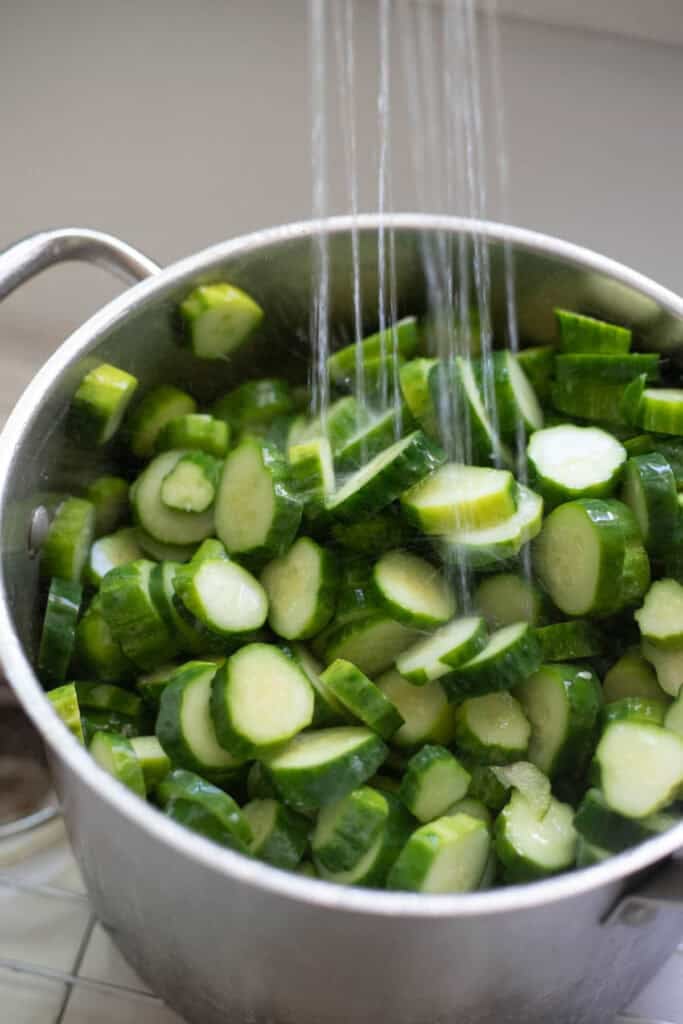
Step 4: After the second soak, pour off the water and thoroughly rinse the cucumbers in a colander. Repeat the rinsing process three more times, straining during each rinse to remove all lime. Return the cucumbers to a large, clean bowl.
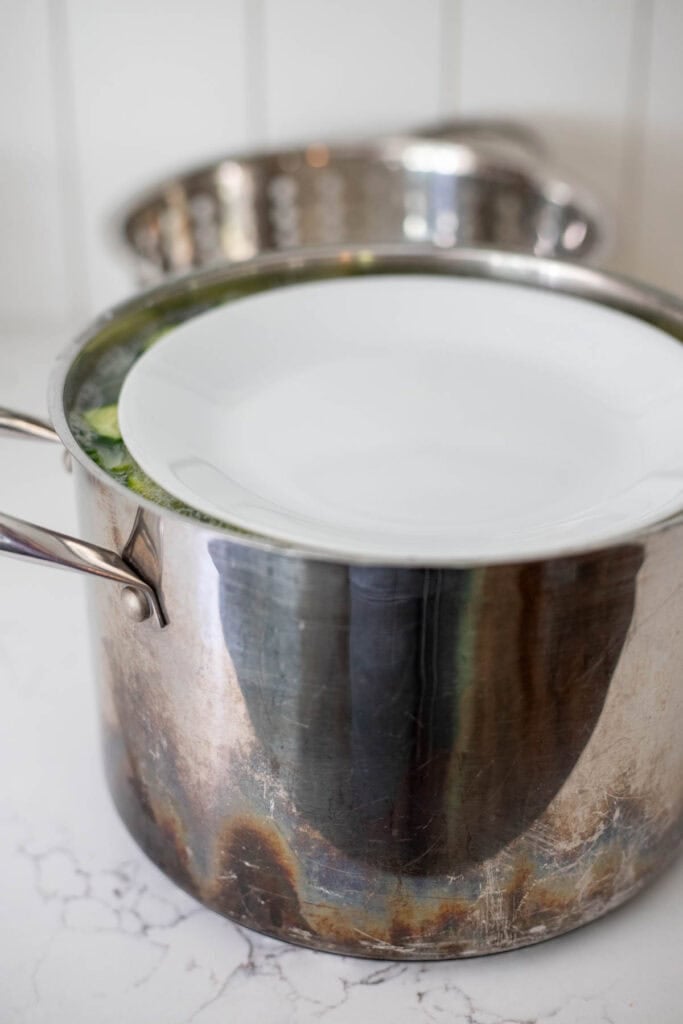
Step 5: Prepare the brine by mixing the vinegar, sugar, salt, and pickling spices in a large pot. I add the pickling spices to a tea ball so I can keep the flavor and remove the actual spices. Warm the brine over medium-low heat, whisking until the sugar dissolves. Cool to room temperature, then pour over the cucumbers and let them rest for 6 hours or overnight in the refrigerator. Cover with a towel or lid.
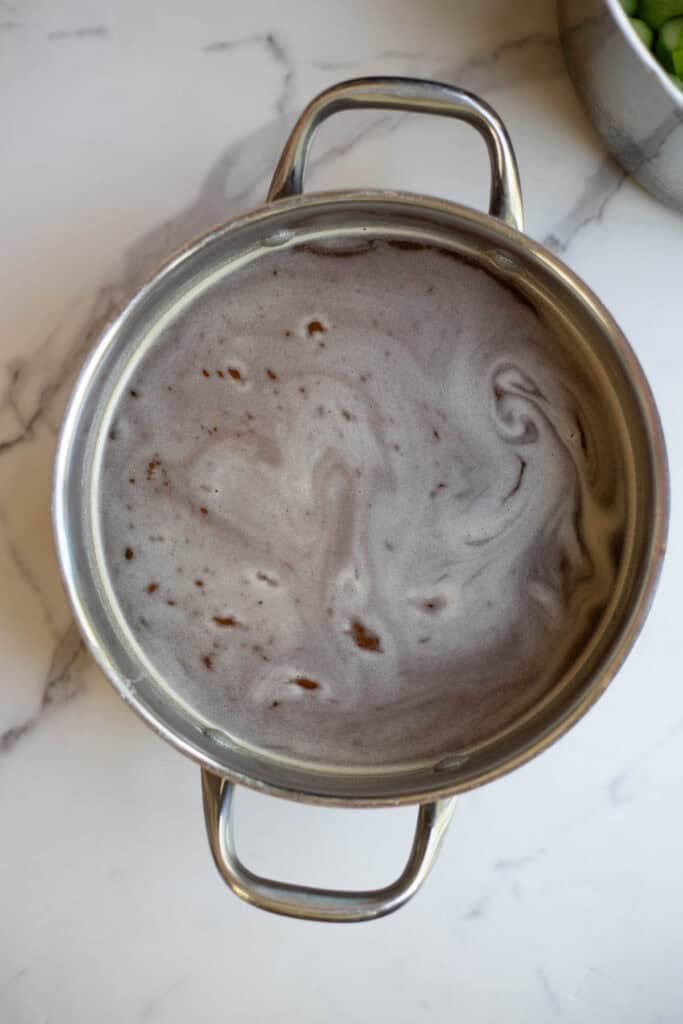
Step 6: After the brine soak, strain the brine into a large pot and simmer on the stovetop for 30 minutes. Simmering the brine removes the water that was released from the cucumbers, returning the brine to its former vinegar-heavy concentration.
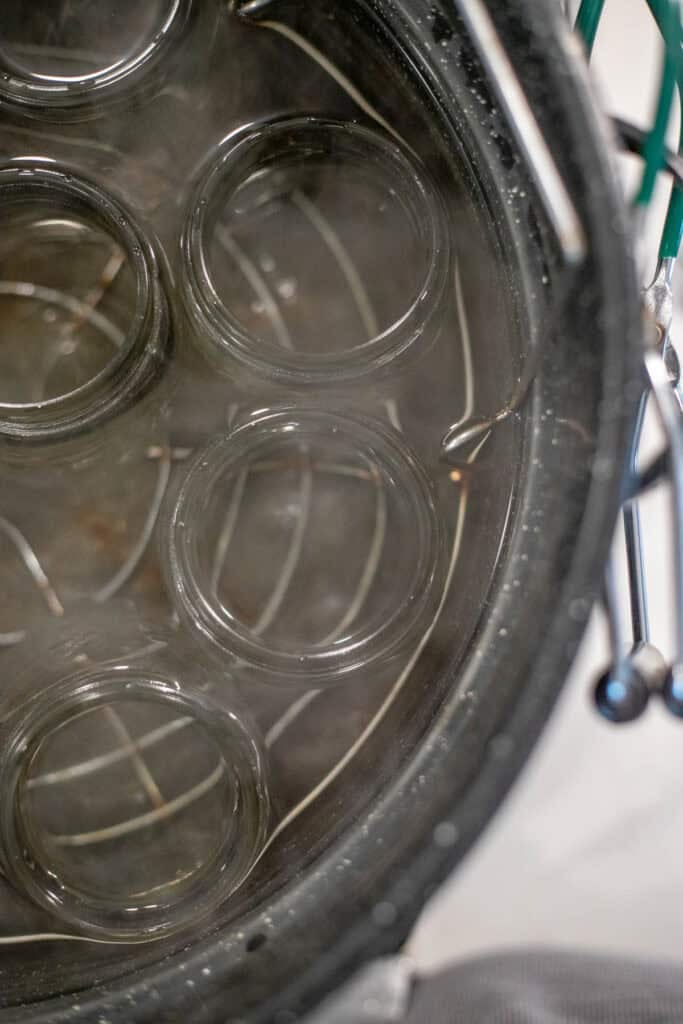
Step 7: While the brine simmers, prepare the water bath canner by filling it with water and setting it to a full boil. Wash the canning jars and lids in hot, soapy water, rinse well, and place the jars in the canner to stay hot. Place the lids on a clean towel on the counter.
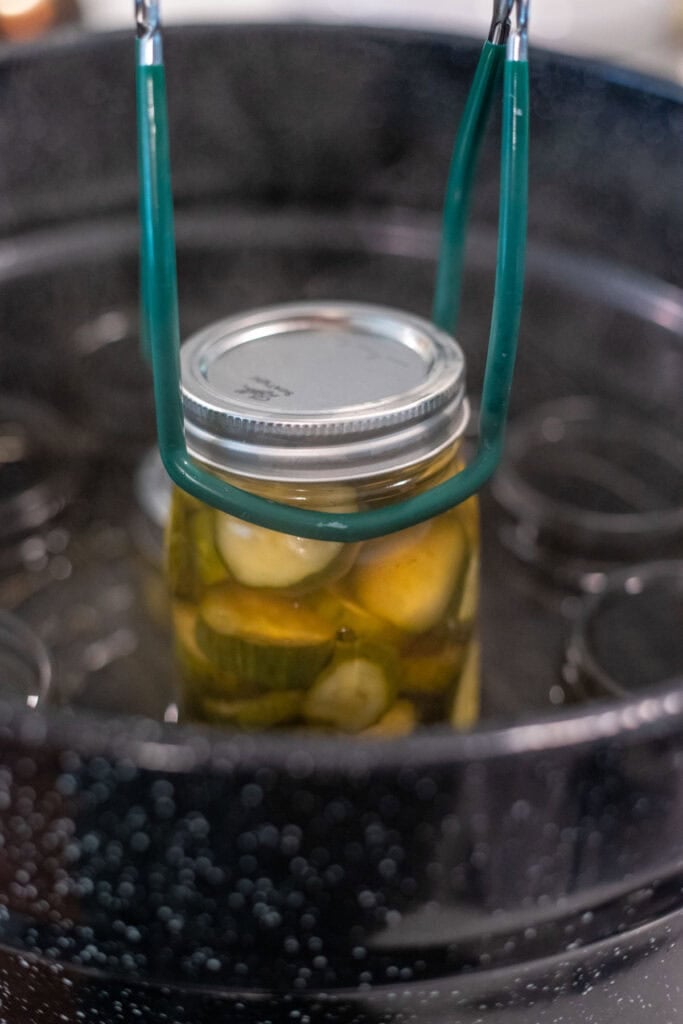
Step 8: After the brine has finished simmering, add 1/8 teaspoon of mustard seeds to the bottom of each hot jar, then pack the cucumbers in. Pour in brine until it covers the cucumbers. I work with two to three jars at a time so that they stay warm. Remove air bubbles and leave 1/2 to 1 inch headspace at the top of the jar. Wipe the rims, add lids and bands, and carefully return the filled jars to the canner, keeping them upright. A jar lifter is helpful for this part. Process for 10 minutes at a full rolling boil for pint jars. Quart jars will process for 15 minutes. After processing, carefully remove the jars from the water with a jar lifter, placing on a heat-safe surface until fully cooled. Store in a cool, dark place for up to one year.
Tips
- Do not adjust the proportions of food or brine in canning recipes. Trusted recipes use precise acidity levels to eliminate the risk of contamination.
- Do not skip the rinses. Multiple rinses remove the pickling lime. Residual pickling lime raises alkalinity, which interferes with the acidity levels that are necessary for safe food preservation.
- You don’t need to sterilize jars before processing if the processing time is at least 10 minutes. Be sure to adjust your processing time for your altitude. Visit the Ball and Mason Jar website for a helpful chart of altitude time adjustments.
- Add hot pepper flakes for spice.
- You can copy this process using carrots, green beans, or another fresh vegetable sliced thin.
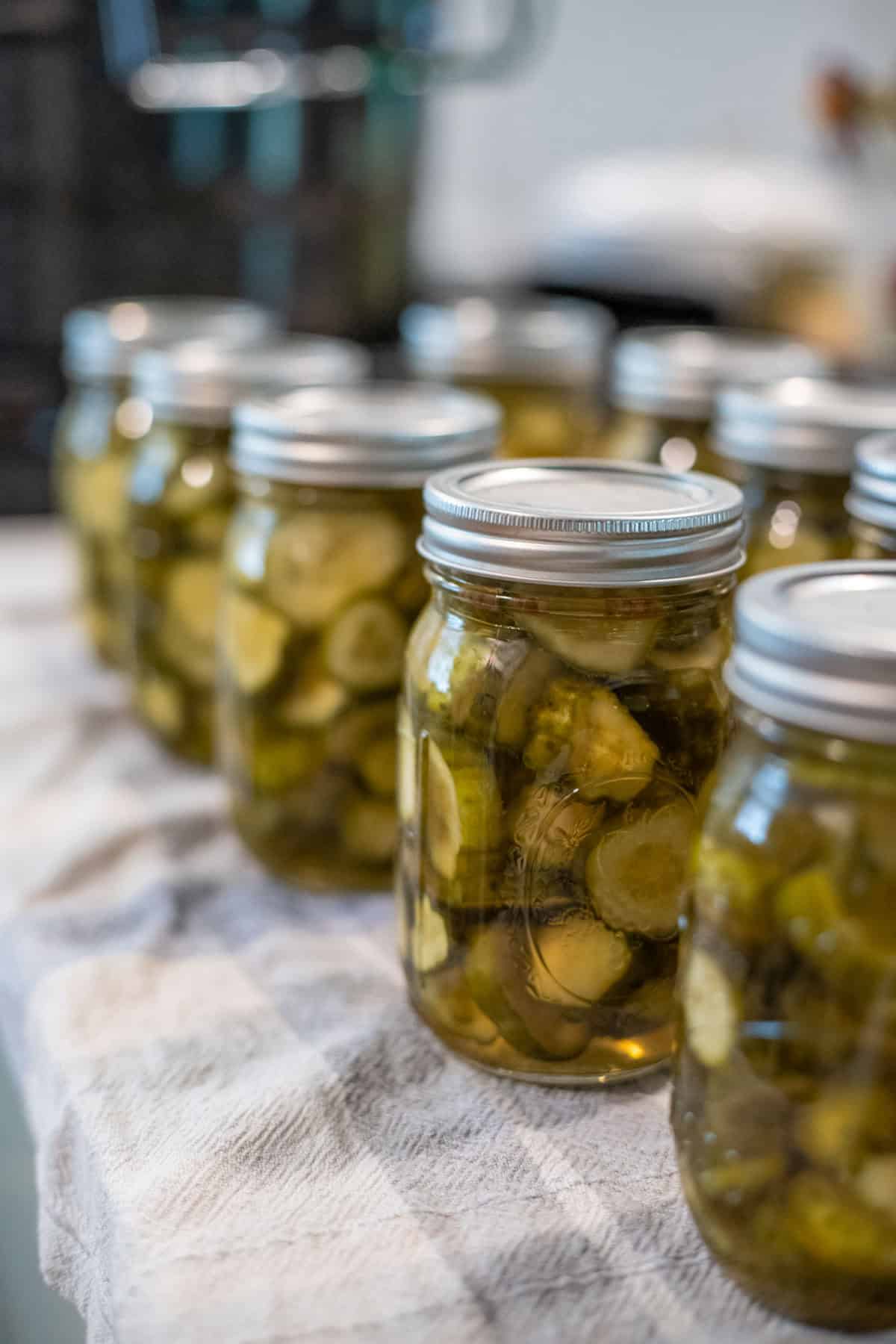
Recipe FAQs
Once fully cooled and properly sealed, store the jars in a cool, dark place for up to one year. Sometimes they last longer than one year, but you should always check for signs of spoilage before consuming.
Pickling lime is a white powder known as food-grade calcium hydroxide. It is used to boost the crispness of cucumbers or other vegetables by strengthening and firming up the pectin. Recipes with pickling lime should be followed closely to ensure a safe product. Rinsing is important, as is maintaining the proper pH for canning.
If you have a lot of leftover pickling lime, you can simply keep it cool, dry, and sealed as thoroughly as possible. It will keep for a long time, though you should check for hardening before use. If moisture reaches the pickling lime, it may harden and lose effectiveness.
Yes! Higher altitudes have a lower boiling point, therefore longer processing times. Visit the Ball and Mason Jar website for a helpful chart of altitude time adjustments.
More Recipes from the Farmhouse
- Homemade Peach Preserves
- How to Freeze-Dry Eggs
- Homemade Fermented Pickles
- How to Make Sauerkraut
- Fermented Peppers
If you try this recipe and love it, I would love it if you could come back and give it 5 stars! Tag me on Instagram @farmhouseonboone.
Old Fashioned Lime Pickles Recipe
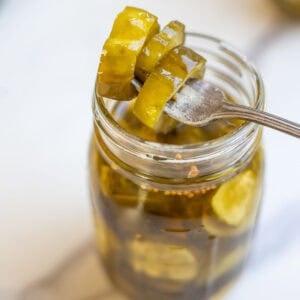
Equipment
- Wide-mouth canning jars, lids, and bands
Ingredients
Lime soak
- 1 gallon of water
- 1/2 cup pickling lime
Pickling brine
- 8-9 pounds pickling cucumbers, small
- 8 cups white vinegar, 5% acidity
- 8 cups white sugar
- 1 tablespoon salt
- 2 tablespoons pickling spices
- mustard seeds, 1/8 teaspoon per jar
Instructions
- Wash and prepare cucumbers, cutting off the blossom ends, and slicing cucumbers into thin medallions about 1/4 inch thick.
- Combine water and pickling lime in a large non-reactive bowl (glass, plastic, ceramic, or stainless steel). Do not use an aluminum bowl. Stir until dissolved, then add the sliced cucumbers. Place a weight over the cucumbers to keep them submerged and soak for 12 hours, stirring occasionally.
- After the first soak is complete, pour off the lime solution and rinse the cucumbers thoroughly in a colander to remove all lime residue. Repeat the rinsing process three times. Add the cucumbers to a large, clean bowl, cover with ice water and a tea towel, and soak for another 3 – 4 hours.
- After the second soak, pour off the water and thoroughly rinse the cucumbers in a colander. Repeat the rinsing process three more times, straining during each rinse to remove all lime. Return the cucumbers to a large, clean bowl.
- To prepare the brine, combine vinegar, sugar, salt, and pickling spices in a large pot. I add the pickling spices to a tea ball so I can keep the flavor and remove the actual spices. Warm the brine over medium-low heat, whisking until the sugar dissolves. Cool to room temperature, then pour over the cucumbers, cover, and let them rest for 6 hours or overnight in the refrigerator.
- After the brine soak, strain the brine into a large pot and simmer on the stovetop for 30 minutes.
- While the brine simmers, prepare the water bath canner by filling it with water and setting it to a full boil. Wash the canning jars and lids in hot, soapy water, rinse well, and place the jars in the canner to stay hot.
- After the brine has finished simmering, add 1/8 teaspoon of mustard seeds to the clean jars, and then pack the cucumbers in. Fill with brine until the cucumbers are covered. I work with two to three jars at a time so that they stay warm. Remove air bubbles and leave 1/2 to 1 inch of headspace. Wipe the rims, add lids and bands, and carefully return the filled jars to the canner, keeping them upright. A jar lifter is helpful for this part. Process for 10 minutes at a full rolling boil for pint jars. Quart jars will process for 15 minutes. After processing, carefully remove the jars from the water with a jar lifter, placing them on a heat-safe surface until fully cooled. Store in a cool, dark place for up to one year.
Notes
Nutrition
Nutrition information is automatically calculated, so should only be used as an approximation.
